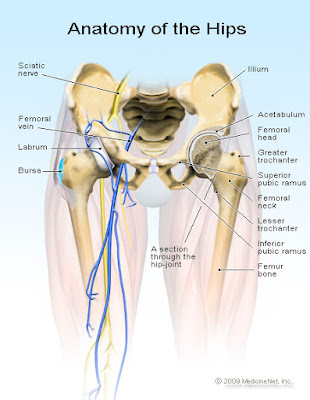What Is Hip Pain?
Facts You Should Know About Hip Pain
The hip is a ball and socket joint that attaches the leg to the torso of the body. In the hip joint, the head of the femur (thighbone) swivels within the acetabulum, the socket, made up of pelvic bones. While many causes of hip pain can arise from the joint itself, there are numerous structures surrounding the hip that can also be the source of pain. Trauma is often the cause of hip pain, but any source of inflammation may cause pain in the hip area. Pain is one of the symptoms of inflammation, along with swelling, warmth, and redness; together these are signals and symptoms that a problem may exist.
Seek medical care if you are concerned that a bone is broken, if you're experiencing fever and swelling, or you have a loss of bladder or bowel function.
Hip pain treatment depends upon your underlying illnesses and diagnosis.
What Causes Hip Pain?
Pain may arise from structures that are within the hip joint or from structures surrounding the hip.
The hip joint is a potential space. This means that normally there is a minimal amount of fluid inside the joint to allow the femoral head to glide in the socket of the acetabulum. Any illness or injury that causes inflammation will cause this space to fill with fluid or blood, stretching the hip capsule lining and resulting in pain.
Articular cartilage lines the femoral head and the acetabulum, allowing the bones to move within the joint with less friction. Also, the socket area of the acetabulum is covered with tough cartilage called the labrum. Just like any other joint cartilage, these areas can wear away or tear and become the source of pain. There are thick bands of tissue that surround the hip joint, forming a capsule. These help maintain the hip joint stability, especially with movement, keeping the femoral head firmly in the acetabulum.
Movement at the hip joint is possible because of the muscles and tendons that surround the hip and that attach across the hip joint, allowing the leg to move in different directions. Aside from controlling movement, these muscles also act together to maintain joint stability. There are large bursas (fluid-filled sacs) that surround areas of the hip and allow the muscles and tendons to glide more easily over bony prominences. Any of these structures can become inflamed.
Pain can be referred from other structures outside the hip joint, meaning that while the hip hurts, the problem may potentially originate elsewhere. Inflammation of the sciatic nerve as it arises from the spinal cord in the back can cause hip pain, especially if the L1 or L2 nerve roots are involved. Other types of nerve inflammation may manifest as hip pain, including pain arising in the lateral femoral cutaneous nerve of the thigh, which is often inflamed in pregnancy. Pain from an inguinal or femoral hernia, or a sports hernia (athletic pubalgia) may also cause pain that is felt in the hip.
Hip pain is a nonspecific complaint that requires the health care professional to find the underlying cause from the many potential injuries or illnesses. The approach to the diagnosis of hip pain requires an open mind because the source of trauma or the cause of illness may not be readily apparent.
Dr Sunil Rajan is leading one of the best Orthopaedic surgeon and Knee specialists in Indore. If you are planning to consider knee, Hip and Shoulder replacement surgery in Indore so contact to Dr Sunil Rajan. Book an Appointment today call us at 9826200015 and online visit for more informatoin - https://www.drsunilrajan.com
Book an Appointment Today :- https://www.drsunilrajan.com/contactus.htm
Please go through our social media :
like our page to know more about joint replacement surgeon.
Facebook : https://www.facebook.com/drrajankneeclinic/
Please do follow on Instagram
Instagram : https://www.instagram.com/drsunil_rajan/
To More Post: - What Is a Knee Joint Replacement?




Comments
Post a Comment